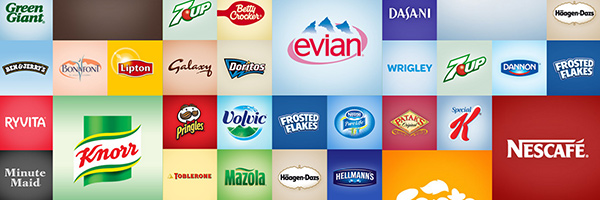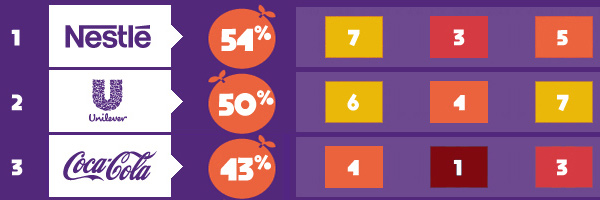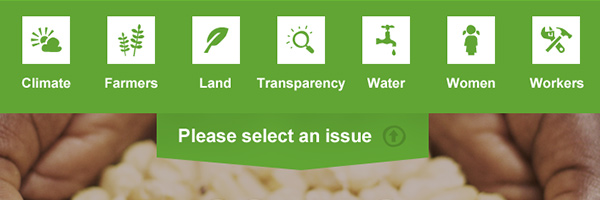Main content
About
DOWNLOADS
BRIEFING PAPERS
The Journey to Sustainable Food: A three-year update on the Behind the Brands campaign
This report provides an overview of the progress Behind the Brands has made over the past three years by challenging the 'Big 10' food and beverage companies to take action on social and environmental policies and practices.
Standing on the Sidelines: Why food and beverage companies must do more to tackle climate change
Oxfam explains how greenhouse gas emissions produced by the supply chains of the 'Big 10' are driving climate change and therefore hunger, and calls on these companies to address this.
![]()
Behind the Brands: food justice and the 'Big 10' food and beverage companies (PDF)
In this report, Oxfam assesses the social and environmental policies of the world’s ten largest food and beverage companies and calls on them to take the critical next steps to create a just food system.
Race to the top: One year of looking Behind the Brands (PDF)
The ten biggest food and beverage companies in the world are slowly waking up to their responsibilities to help tackle some immense challenges facing the global food system.
Declaration of Interest: Financial and Programmatic Ties Between Oxfam and The Big 10 (PDF)
Oxfam is committed to being fully transparent and accountable for all its relationships with companies including the Big 10 in the context of the Behind the Brands campaign.
OPEN DATASHEETS
Interactive Excel spreadsheet of indicator data (MS Excel) Access the raw data used to create our scorecard. All indicators, categories and scores organised by theme and company.
A GUIDE TO UNDERSTANDING OUR DATA
Behind the Brands methodology summary (PDF - English language only)
A more detailed version of this page and the ideal companion to understanding the indicator data.
THE SCORECARD
The latest version of our companies scorecard as a print-quality PDF.
Behind the Brands Companies Scorecard - April 2016 (PDF)
Read what the top ten food and beverage companies had to say about the latest Behind the Brands scorecard ratings here.
Intro
Behind the Brands is part of Oxfam’s GROW campaign to help create a world where everyone has enough to eat. Right now, nearly one in eight people on earth go to bed hungry. Sadly, the majority of these people are farmers or farm workers supplying the very food system that is failing them. Yet there is enough food for everyone. That’s an outrage – but we can be the generation that ends this crazy situation.
While the food system is complex and its problems multi-faceted, we know that the world’s largest food and beverage companies have enormous influence. Their policies drive how food is produced, the way resources are used and the extent to which the benefits trickle down to the marginalised millions at the bottom of their supply chains.
Oxfam’s Behind the Brands campaign aims to provide people who buy and enjoy these products with the information they need to hold the Big 10 to account for what happens in their supply chains. In putting together a scorecard based entirely on publicly available information on company policies, we posed the question “what are they doing to clean up their supply chains”?
The companies
The Behind the Brands Scorecard assesses the agricultural sourcing policies of the world's 10 largest food and beverage companies. It exclusively focuses on publicly available information that relates to the policies of these companies on their sourcing of agricultural commodities from developing countries.
We based our selection on companies with the largest overall revenues globally, as well as their position in the Forbes 2000 annual ranking, which measures companies on the basis of composite sales, assets, profits and market value.
The ten companies ("the Big Ten") assessed in the Scorecard (in order of company size) are:
Nestle
PepsiCo
Unilever
Mondelez
Coca-Cola
Mars
Danone
Associated British Foods (ABF)
General Mills
Kellogg’s
The issues
The Scorecard looks at seven themes, weighing each theme equally. The seven themes are:
- Transparency at a corporate level
- Women farm workers and small-scale producers in the supply chain
- Workers on farms in the supply chain
- Farmers (small-scale) growing the commodities
- Land, both rights and access to land and sustainable use of it
- Water, both rights and access to water resources and sustainable use of it
- Climate, both relating to reducing green house gas emissions and helping farmers adapt to climate change
The indicators
The Scorecard approaches six of the seven themes (all except transparency) in a similar way. Within these six themes, the indicators are grouped into four indicator categories (each worth one quarter of the score available for that theme): (i) awareness; (ii) knowledge; (iii) commitments; and (iv)supply chain management. These indicator categories rely on publicly available documents to address the following questions:
- Awareness: Does the company demonstrate general awareness of key issues relating to that theme and does it conduct projects to understand and address these key issues?
- Knowledge: Does the company demonstrate it measures, assesses and reports key issues and facts specifically in its supply chains that relate to that theme?
- Commitments: Does the company commit to addressing the key issues relating to that theme in its supply chains?
- Supply chain management: Does the company require its suppliers to meet relevant standards related to that theme?
The transparency theme is structured differently. It has a broader focus and rewards companies for disclosure on cross-cutting and corporate level issues.
What we did not assess
Across the Scorecard, some important issues that relate to the policies and practices of companies are not assessed. The scorecard is focused on the agricultural sourcing operations of the Big 10 companies so issues that do not relate to these “upstream” activities were not included. This includes critical issues such as nutrition, some of which are covered by other initiatives. Other issues we could not assess include actual practices on farms and exactly how the Big 10, in practice, use their power to shape the behavior of their suppliers. Such issues were not included for the following reasons:
a) we decided that a particular issue was not linked closely enough to the lives of small-scale farmers, farm workers and communities in the supply chains of the Big 10;
b) we were unable to find indicators that could assess the issue adequately through use of publically available information; or
c) public information available was not of adequate quality and accuracy for us to assess companies.
Where to from here?
Find out more
Download an extended version of this article for more detail or to help you understand our data.
Visit the live web version of the Behind the Brands Companies Scorecard and navigate by issue or company.
Visit the campaign news section for recent updates and company responses.
-

Browse by Brand
Select your favourite brand to see which parent company they are owned by and how they score.
-

Grow Food Companies Scorecard
See how all of the parent companies score across all issues in an easy to digest scorecard.
-

Browse by Issue
Select which issue you feel most strongly about to see how the parent companies compare against each other.

